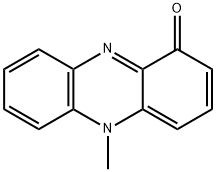| Company Name: |
Guangzhou Isun Pharmaceutical Co., Ltd
|
| Tel: |
020-39119399 18927568969 |
| Email: |
isunpharm@qq.com |
| Products Intro: |
Product Name:Pyocyanin
CAS:85-66-5
Purity:98% (HPLC) Package:5MG; 25MG; 100MG; 1G
|
Pyocyanine manufacturers
- Pyocyanine
-

- $0.00 / 1g
-
2019-11-08
- CAS:85-66-5
- Min. Order: 1g
- Purity: 99.5%min
- Supply Ability: 20kg/week
|
| | Pyocyanine Basic information |
| Product Name: | Pyocyanine | | Synonyms: | Pyocyanine;1-Oxylato-5-methylphenazin-5-ium;5-Methyl-1(5H)-phenazinone;Sanasin;Sanazin;Pyocyanin, Ready Made Solution from Pseudomonas aeruginosa;pyocyanin;5-methylphenazin-1-one | | CAS: | 85-66-5 | | MF: | C13H10N2O | | MW: | 210.23 | | EINECS: | | | Product Categories: | | | Mol File: | 85-66-5.mol |  |
| | Pyocyanine Chemical Properties |
| Melting point | 133° | | Boiling point | 349.76°C (rough estimate) | | density | 1.1427 (rough estimate) | | refractive index | 1.5300 (estimate) | | storage temp. | -20°C | | solubility | DMSO: soluble | | form | solid | | pka | 2.42±0.20(Predicted) | | color | Dark blue | | Stability: | Stable for 2 years from date of purchase as supplied. Solutions in DMSO may be stored at -20° for up to 1 week. |
| Hazard Codes | Xn | | Risk Statements | 22-41 | | Safety Statements | 26-39 | | WGK Germany | 1 |
| | Pyocyanine Usage And Synthesis |
| Description | Pyocyanine (85-66-5), a redox-active phenazine produced by?P. aeruginosa?and other pathogens, is an electron receptor, which stimulates redox cycling in bacteria as well as in a variety of human cell lines. It enhances oxidative metabolism, which increases the formation of intracellular reactive oxygen species (ROS) via reduction of NADPH. Pyocyanine accelerates neutrophil apoptosis?in vitro. Pyocyanine production by?P. aeruginosa?suppresses the acute inflammatory response by pathogen-driven acceleration of neutrophil apoptosis and associated reduction of local inflammation. | | Uses | Pyocyanin is an antibiotic accelerator of neutrophil apoptosis. | | Uses | Pyocyanin has been used:
- To disable the ability of forkhead box A2 (FOXA2) to regulate goblet cell hyperplasia and metaplasia (GCHM) and mucin expression.
- To activate nuclear factor (erythroid-derived 2)-like 2 (NRF2) through the reactive oxygen species (ROS)-inducible epidermal growth factor receptor (EGFR)-phosphoinositide 3-kinase (PI3K) cellular signal transduction pathway and its downstream effectors.
- To stimulate Pseudomonas aeruginosa PAO1 cell line adhesion and invasion in human lung carcinoma A549 cells via reactive oxygen species (ROS) production.
| | General Description | Pyocyanin is a secondary metabolite, which is produced by Pseudomonas aeruginosa. | | Biochem/physiol Actions | Pyocyanin, a blue-green pigment belonging to phenazine pigments, is a redox-active phenazine. Pyocyanin is an electron receptor, which stimulates redox cycling in bacteria, liver cells, and human epithlial cell lines. Pyocyanin enhances the oxidative metabolism, which in turn increases the formation of intracellular reactive oxygen species (ROS) via reduction of NADPH. Pyocyanin also increases the release of IL-8 by airway epithelial cells both in vitro and in vivo. This involves signal transduction pathways that include oxidants, protein tyrosine kinases, and MAP kinases. IL-8 secretion by these cells is in synergy with inflammatory cytokines. Pyocyanin has been shown to accelerate neutrophil apoptosis in vitro, resulting in resolution of acute inflammation, which is beneficial for bacteria survival. | | Enzyme inhibitor | This natural pigment (FW = 210.24 g/mol), which has an antifungal activity, is a secretory agent produced by Pseudomonas aeruginosa (formerly P. pyocyanea and Bacillus pyocyaneus). It is a blue solid that is soluble in chloroform and pyridine generates reactive oxygen species, such as superoxide and hydrogen peroxide. Pyocyanine is slightly soluble in cold water and the aqueous blue solution can be decolorized under alkaline conditions upon the addition of glucose or sodium hydrosulfite. Target(s): catalase; cytochrome P450 leukotriene B4 w-oxidation; and diamine oxidase. | | Purification Methods | It crystallises from H2O as dark blue needles. The picrate has m 190o (dec). [Beilstein 23 H 395, 23 I 59, 23 II 234, 23/8 V 395.] | | References | 1) Rada and Leto (2013),?Pyocyanin effects on respiratory epithelium: relevance in Pseudomonas Aeruginosa airway infections; Trends Microbiol.,?21?73
2) Reszka?et al. (2012),?Inactivation of the potent Pseudomonas aeruginosa cytotoxin pyocyanin by airway peroxidases and nitrite; Am. J. Physiol. Lung Cell Mol. Physiol.,?302?L1044 |
| | Pyocyanine Preparation Products And Raw materials |
|